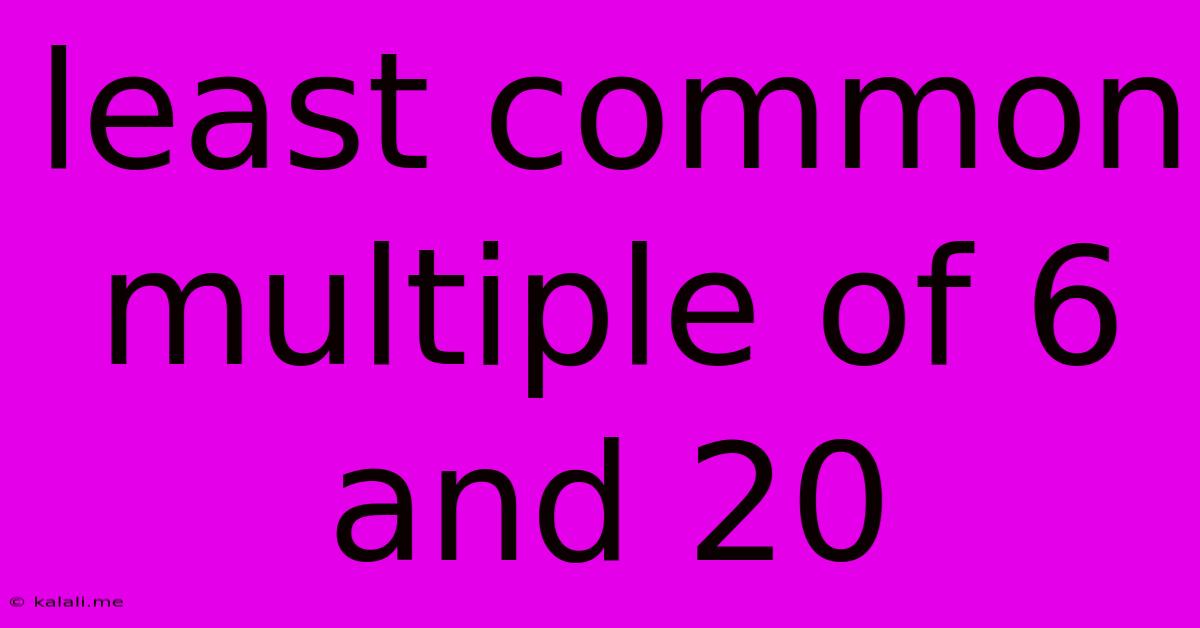Least Common Multiple Of 6 And 20
Kalali
Jun 13, 2025 · 3 min read

Table of Contents
Finding the Least Common Multiple (LCM) of 6 and 20
This article will guide you through understanding and calculating the least common multiple (LCM) of 6 and 20. We'll explore different methods, making this concept clear and accessible, whether you're a student brushing up on your math skills or simply curious about number theory. Understanding LCM is crucial in various mathematical applications, including simplifying fractions and solving problems involving ratios and proportions.
What is the Least Common Multiple (LCM)?
The least common multiple (LCM) is the smallest positive integer that is a multiple of two or more numbers. In simpler terms, it's the smallest number that both numbers can divide into without leaving a remainder. For example, the LCM of 2 and 3 is 6, because 6 is the smallest number that is divisible by both 2 and 3.
Methods for Finding the LCM of 6 and 20
There are several ways to calculate the LCM of 6 and 20. Let's explore two common approaches:
1. Listing Multiples
This method involves listing the multiples of each number until you find the smallest multiple that is common to both.
- Multiples of 6: 6, 12, 18, 24, 30, 36, 42, 48, 60, ...
- Multiples of 20: 20, 40, 60, 80, 100, ...
By comparing the lists, we can see that the smallest common multiple is 60. Therefore, the LCM of 6 and 20 is 60. This method is straightforward for smaller numbers, but can become cumbersome with larger numbers.
2. Prime Factorization Method
This method uses the prime factorization of each number. Prime factorization is expressing a number as a product of its prime factors (numbers divisible only by 1 and themselves).
- Prime factorization of 6: 2 x 3
- Prime factorization of 20: 2² x 5
To find the LCM using prime factorization:
- Identify the highest power of each prime factor present in the factorizations. In this case, we have 2², 3, and 5.
- Multiply these highest powers together. 2² x 3 x 5 = 4 x 3 x 5 = 60
Therefore, the LCM of 6 and 20 is 60 using the prime factorization method. This method is generally more efficient for larger numbers.
Why is the LCM Important?
The LCM has several practical applications in mathematics and beyond:
- Adding and Subtracting Fractions: Finding a common denominator when adding or subtracting fractions requires finding the LCM of the denominators.
- Solving Problems Involving Ratios and Proportions: LCM helps determine the smallest common quantity when dealing with ratios and proportions.
- Scheduling and Time Management: The LCM can be used to solve problems related to repeating events, such as determining when two events will occur simultaneously.
Conclusion
Calculating the least common multiple is a fundamental skill in mathematics. Whether you use the method of listing multiples or prime factorization, understanding the concept of LCM is essential for solving a variety of mathematical problems. We've demonstrated that the LCM of 6 and 20 is 60, using both methods to illustrate the process clearly. Remember to choose the method that best suits your needs and the complexity of the numbers involved.
Latest Posts
Latest Posts
-
Which Of The Following Is Not Considered Appropriate Email Etiquette
Jun 14, 2025
-
Which Of The Following Is Not A Major Mineral
Jun 14, 2025
-
Whats The Square Root Of 149
Jun 14, 2025
-
What Are The Factors For 62
Jun 14, 2025
-
Si Unit For Density Of Water
Jun 14, 2025
Related Post
Thank you for visiting our website which covers about Least Common Multiple Of 6 And 20 . We hope the information provided has been useful to you. Feel free to contact us if you have any questions or need further assistance. See you next time and don't miss to bookmark.